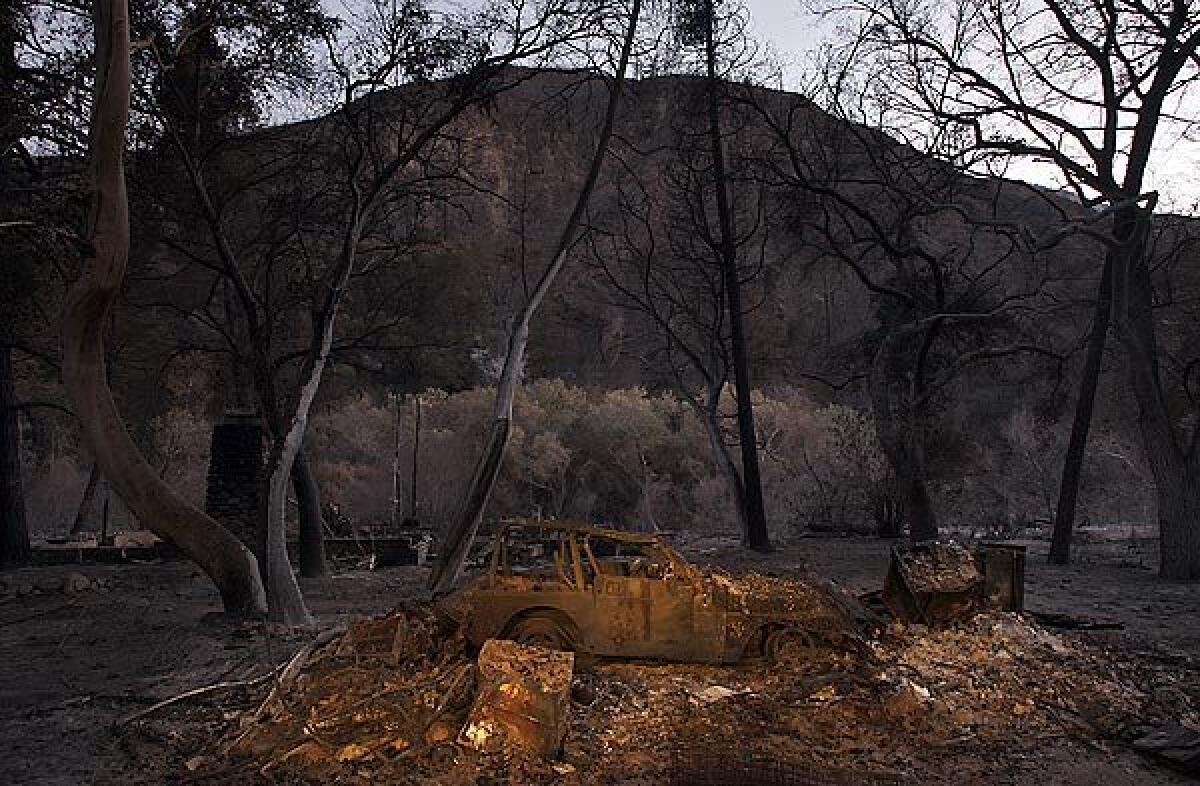Inquiry faults Forest Service on Station fire, but leaves questions

- Share via
A federal inquiry has concluded that the U.S. Forest Service failed to use all the aircraft that might have been available during the critical early hours of the 2009 Station fire, but the findings left unanswered key questions of why the planes and helicopters were not deployed.
The report Friday by the Government Accountability Office, the investigative arm of Congress, also said the Forest Service should clarify its policies on using aircraft and ground crews from local and state agencies.
In addition, the GAO called on the Forest Service to develop a strategy for when planes and helicopters should be flown at night.
The Forest Service has been reevaluating its night-flying policy since shortly after the Station fire, the biggest blaze in Los Angeles County history.
The GAO launched its inquiry a year ago at the request of several Congress members.
That followed a series of Times reports showing that the Forest Service misjudged the threat posed by the fire at the end of the first day, rolled back its ground forces and did not follow through on its commander’s orders for a heavy air attack early the next morning.
Some critics of the Forest Service’s handling of the fire said the inquiry should have gone further in clearing up whether poor decisions, including any motivated by budget worries, hampered the firefight in the Angeles National Forest.
Bronwen Aker, a resident of Big Tujunga Canyon, where dozens of homes burned, dismissed the report as a “bureaucratic two-step, saying little that has not been said before and making excuses for why it does not draw any conclusions about the events it reports.”
William Derr, a former Forest Service investigator, said the report is “less than complete.”
Anu Mittal, a GAO director who headed the inquiry team, said it “tried to provide as many facts as we could find,” but sometimes they were left with differing accounts of the same circumstances, such as those involving the aircraft orders.
A Forest Service commander ordered air tankers and helicopters to begin hitting the fire at 7 a.m. on Day 2, but most did not arrive until 9 a.m. or later.
By then the fire had leaped a defense line along Angeles Crest Highway and began to rage out of control.
It burned until mid-October, blackening 250 square miles of the forest, destroying more than 200 homes and other structures and killing two county firefighters.
Three weeks before the Station fire broke out, the Forest Service issued a memo instructing managers to pare costs by limiting the use of state and local agencies on federal fires.
Forest Service officials have denied that the memo slowed the response to the Station fire, but the GAO found that some incident managers believed the directive did cause delays in the arrival of equipment and crews.
The Forest Service has said it staged the morning air assault as soon as possible, but there had been a lack of available federal tankers with rested pilots.
However, Forest Service records show that the aircraft order was not formally processed. On this point, the government investigators again heard conflicting stories of what happened.
A Forest Service dispatcher told them she was instructed by an aircraft coordination center “not to formally submit” the order until officials knew which aircraft would be assigned.
A dispatcher at the coordination center disputed that, however, “saying she does not recall this conversation and would never tell a dispatcher not to formally submit a request,” according to the report.
The inquiry concluded that federal planes probably could not have reached the fire earlier, although it said the Forest Service could have ordered state air tankers, as The Times has reported.
The GAO said that a state Department of Forestry and Fire Protection official “estimated that if the tankers had been requested, they might have been able to arrive at the Station Fire at approximately 7 a.m., but he told us that because the request was never made, he does not know whether the air tankers would or would not have been available.”
According to the GAO, Forest Service officials said they believed that the state would not have released the tankers because they might have been needed for any new blazes that erupted that day. In addition, the investigators noted that, on the first evening of the fire, the Forest Service did not use a large Martin Mars tanker that was nearby.
The GAO findings said there were divergent accounts of why the plane was not deployed.
The agency said it could not be determined whether a more aggressive aerial assault or other tactics would have halted the fire.
“It is not possible to know with certainty whether different decisions or actions would have resulted in a different outcome for the Station Fire,” the GAO said.
In a statement, Rep. Brad Sherman (D-Sherman Oaks) said the findings underscore the need for the Forest Service to improve its measures for quickly ordering aircraft and ground crews, including those from other agencies.
“It also brings up questions as to whether or not certain tactics could have helped firefighters suppress the fire and protect homes, despite the overwhelming challenges posed by the intensity of the fire and steep terrain,” he said.
--
More to Read
Sign up for Essential California
The most important California stories and recommendations in your inbox every morning.
You may occasionally receive promotional content from the Los Angeles Times.










